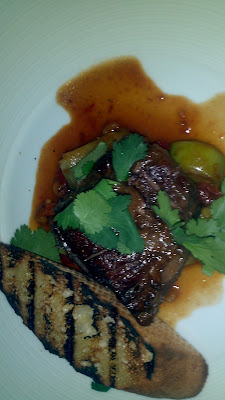 |
| Typical Water Bath Canner - Used for canning high acid foods |
Canning has always been a Zen experience for me. I love taking all the wonderful fresh
ingredients of summer, cooking them down and turning them into jars that look
like little jewels. It’s wonderful to
crack open a jar of jam in January and be able to spread the taste of summer
peaches on a biscuit. I give away most
of what I make and it’s a gift that’s more personal and from the heart than
anything I could ever get from the store.
Every year I try to find something new to try. If it’s a hit, it becomes part of the list of
“must make” recipes for the next year.
Last year’s new additions were Cherry Preserves, Apple Butter and Sweet
Jalapeno Slices. This year’s new
favorite is Heirloom Hot Sauce, made with heirloom tomatoes and Serrano peppers
from our CSA share. My list of “must
make” recipes is up to 12 recipes now, so my summers are pretty busy in the
kitchen.
 |
| Heirloom Tomatoes - They have amazing flavor |
There can be no discussion about my canning passion without
revealing the truth of why I started doing it in the first place. It was the summer of 1988 and Tom and I had
been living in our new house for about 6 months. I was in a very domestic frame of mind and was
looking to expand my cooking repertoire.
My mom had canned pickles a few times over the years so I thought I
would give it a try. I made Bread &
Butter pickles and was pretty pleased with how they turned out. The Gwinnett County Fair was coming up that
September and on a lark, I submitted a jar to compete in the Adult Food
Preservation contest.
And then it happened.
I won the blue ribbon!
I couldn’t believe it.
To give you an idea how excited I was, I immediately ran to the bank of
pay phones (pre-cell phones) and called my mom and my mother-in-law. I had never won anything in my life and it
felt good. I was hooked. I liked winning and I wanted to do it again.
So I did.
Over the years since that first win, I have managed to win 60
ribbons. To date, I
have 29 Blues, 14 Reds and 17 Whites under my belt. I don’t have them on display; they are tucked
away in a special box just for them.
It’s good enough for me just to know I have them.
Every year I convince myself that the streak is going to end and we won't win anything. I am nervous up to the point we go to the fair and look at the winner's list. But happily, we had another winning season at this year’s fair. We took away 2 Blues, 2 Reds and 1 White. (I am making a point to say we because none of this is possible without Tom. He is in this as much as I am. He has carted bushels of produce; pitted
mountains of cherries and been an unwavering source of support the whole way.)
One of this year’s Blues was awarded to one of my most
consistent winning recipes: Peach
Pineapple Orange Conserve. (I am
reluctant to give out any of my winning recipes but my niece Anna specifically
asked for this one, so I must oblige.) This
spread is also one of my most versatile recipes. It is delicious slathered on toast or
biscuits. It also makes a fantastic
glaze for ham. I have mixed it with a
little bit of soy and used it to glaze a chicken on the smoker. I think it would be beautiful glaze for
salmon. Or, if you are so inclined, just
eat it straight from the jar.
 |
| This never gets old! |
Peach Pineapple
Orange Conserve
8 to 10 medium
peaches
2 medium oranges1 8 oz. can crushed pineapple (undrained) – I use juice packed
6 cups sugar
Peel, pit and then finely chop peaches in a food processor
to yield 4 cups of fruit and juice.
Wash but don’t peel oranges.
Remove any seeds and finely chop the oranges in a food processor.
 |
| Thank God for food processors! Chopping these oranges would take forever with a knife. |
Put the chopped peaches and oranges into a 6 to 7 quart pot. Add the crushed pineapple and sugar and stir
until well combined. Cook uncovered over
medium heat, stirring frequently, for about 35 minutes until thickened.
 |
| Big ol' pot of yummy goodness! |
While the conserve is cooking, sterilize your jars. Put 10 clean half pint jars into your canner
(a lidded stockpot with a wire cake rack in the bottom will work as a canner),
fill it with water to cover the jars and boil the jars for 10 minutes. Keep the jars in the hot water until ready to
fill your jars. Prepare your two-piece
lids just before beginning to fill your jars by putting them in a pan or bowl
and pouring boiling water over them.
When the conserve is ready, fill your jars, one or two at a
time, up to 1/8 of an inch of the rim. (Anything
you can should be very, very hot when you pack into the jars.) Wipe the jar rim and put on the two piece
lid, tightening the ring portion of the lid.
Wiping the jar rim carefully is very important, as if there is anything
between the lid and the jar rim, the lid won’t seal properly. Return the filled jar to the rack in the
canner. After all the jars have been
added back to the canner, the water should be at least two inches about the
tops of the jars. Add more hot water if needed.
 |
| These two accessories are essential for canning. The jar lifter and lid lifter keep your hands far away from the hot water. They are found easily at the grocery store or online. |
Turn the heat under the canner to high and bring the water
to a rolling boil. Your processing time
begins only when the water reaches a full boil.
Process the conserve for 15 minutes.
After 15 minutes, carefully remove the jars and set them on the counter that
has been covered with a kitchen towel.
The glass jars are at their most fragile state when they are fresh out
of canner and the towel makes a nice soft surface for cooling.
As the jars cool, you will begin to hear a little pop as
each lid seals. After the jars have completely cooled, to check if the lids
have sealed, press down on each lid with your finger. If it moves up and down, the lid did not seal
and you will need to put that jar in the fridge and eat the contents within a
couple of weeks. If you are diligent
about wiping the jar rims, this shouldn’t be an issue.
So there, my secret is out.
I can say that being thrifty, preserving local foods and giving homemade
gifts are my motivation for canning and I would be telling the truth. But the whole truth would have to include the
simple, All-American desire to win and keep winning. I can live with that.



















.jpg)


















